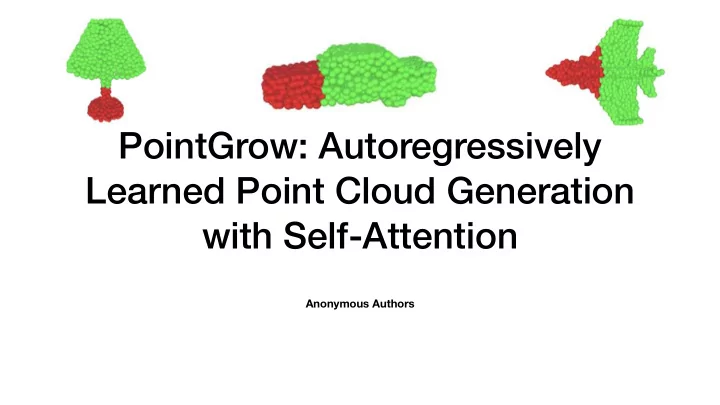

PointGrow: Autoregressively Learned Point Cloud Generation with Self-Attention Anonymous Authors
Key Ideas • Generate realistic point cloud from scratch or conditioned on semantic contexts • Recurrent sampling operation • Augment with dedicated self-attention to capture long-range inter-point dependencies • Learn a smooth manifold of image conditions
Recurrent Point Generation • Estimate conditional distribution of point given all preceding points • Use discrete softmax to decide next point • handle irregularity of point cloud • Encode diverse local structure
PointGrow • Assign a probability to each point cloud by factorization • Unconditional: • Conditional:
Context Awareness Operation • Fetching and averaging pooling
Capture Long-Range Dependencies
Self-Attention Fields • Distance between query point context feature to its accessible points (inaccessible ones marked as infinity)
Magic Show
Learning Representations and Generative Models for 3D Point Clouds Anonymous Authors
Key Ideas • This is the first deep generative model for point clouds • A new autoencoder + GAN architecture for point clouds • A compact representation with good reconstruction quality is learned • Point cloud metrics study
Network Configurations • AE • Encoder: 1-D convs + feature-wise maximum (symmetric permutation invariant) • Decoder: FCs • Loss: earth mover’s distance / Chamfer distance • AE Raw + GAN • AE Latent + GAN • AE Latent + GMM (works best with CD)
Representation Magic • Unseen shape reconstruction • Part editing: simple additive algebra • Interpolating shapes • Shape analogies • Shape completions • Shape classification • 3D point cloud generation
Show, Attend and Translate: Unsupervised Image Translation with Self-Regularization and Attention Anonymous Authors
Key Ideas • Learn mapping from input image in source domain to output image in target domain • Pair training data is costly in this case (unsupervised needed) • Translated image is perceptually similar to original and appears to be drawn from new domain • Attention module guides translation to focus on subject of interest
Method • Adversarial loss + Perceptual loss + Attention
Model
Magic Show
Geomstats: a Python Package for Riemannian Geometry in Machine Learning Anonymous Authors
Key Ideas • A package specifically targeted to the machine learning community • It has numpy and tensorflow backend, GPU-compatibility • Keras version is also provided • Riemannian geometry education through a hands-on approach
Riemannian Manifold • Growing interest in using Riemannian geometry in machine learning • Input : can belong to or itself is Riemannian manifold (human pose) • Output : can belong to Riemannian manifold (predict camera pose) • Parameters : can be constrained on Riemannian manifold (Stiefel manifold) • Low-dimensional manifold saves computations and memory
Use Cases • Hypersphere • Example: minimization of a scalar field on a sphere • Hyperbolic • Example: relevant to Gaussian space and hierarchical representations • Symmetric Positive Definite Matrices • Example: connectivity graph, covariance, feature constraints • Lie groups SO(n), SE(n) • Example: orientation and pose prediction (rigid transformations), Riemannian geodesic distance
Recommend
More recommend